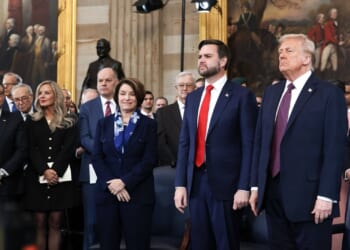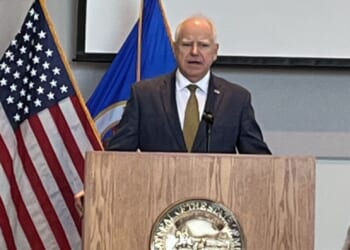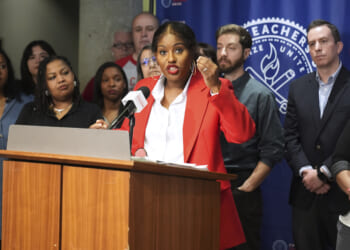New taxes buy the Chicago Transit Authority some time, but state lawmakers failed fix anything that led to the crisis. Here are three ways city leaders can fix the CTA.
While Illinois lawmakers avoided new, statewide tax hikes in their attempts to reform and finance the Chicago area’s public transportation system, they failed to address core financial and operational issues that have long plagued the Chicago Transit Authority.
Rather than burdening downstate residents and non-users with new taxes, legislators opted to shuffle existing revenue streams. The plan diverts $860 million from the state’s motor fuel tax, channels $200 million in annual interest away from the state road fund and authorizes the Regional Transit Authority to increase its local sales tax by 0.25 percentage points in the Chicago area.
It also hits Illinois drivers with higher tolls – an agreement to appease the unions. Tolls will increase 30% for trucks and about 45 cents per trip for cars, raising up to $1 billion annually. Hikes won’t fund public transport but simply replenish the road fund, which is already expected to surpass $6 billion in 2025.
The bill lacks the meaningful consolidation and cost-cutting promised for Chicago-area transit. It only repackages the RTA into the Northern Illinois Transportation Authority. There’s no commitment to meaningful financial accountability. There’s no genuine strategy for reversing ridership decline.
The “transformative investment” lawmakers promised is largely a state bailout for the CTA, whose costs have soared while ridership has collapsed. The agency has shown little inclination, or competence, for addressing either challenge. Even so, lawmakers wrote them a hefty check.
If state lawmakers won’t hold them accountable, it falls to the Chicago City Council and mayor’s office to exert genuine pressure to improve the CTA. Here’s how they can start.
1) Fix the staffing woes
Effective leadership begins with a CTA and NITA board consisting of transit experts. These positions are responsible for contracts, policy and oversight, but are too often a landing spot for political allies rather than transit experts. Board members rarely hold CTA leadership accountable, even in crisis.
During the pandemic, despite plummeting ridership and rising safety concerns, the board publicly praised former-CTA President Dorval Carter Jr. and awarded him regular pay increases. Carter’s out, but much of that board remains. Mayor Johnson must ensure the city’s NITA board appointees are qualified and motivated to improve the system’s issues.
Personnel expenses also consume more than two-thirds of the CTA budget. Of 10,911 CTA employees, nearly half – over 5,000 – are in administration, management and support rather than directly operating trains and buses. To improve service, the CTA needs to reduce overhead and boost the number of drivers.
2) Enforce financial accountability
The most acute financial hazard is the runaway Red Line extension project. Originally budgeted at $3.6 billion, costs have soared to $5.75 billion – an astounding $1 billion per mile. The CTA will absorb $3 billion in debt, up a staggering 747% from the $266 million initially projected. Yet without parallel investments in economic development along the corridor, the extension won’t deliver the fare revenue needed to sustain its operations.
Despite this, the CTA is pressing ahead with the project. It is disregarding cost overruns and federal funding uncertainties, framing it as an “equity issue.” That conveniently ignores that the far South Side is already served by the Metra Electric commuter line and several other rail branches.
3) Restore ridership
Right now, CTA ridership hovers at 70% of pre-pandemic levels, with the fare box covering just 20% of operating expenses. A WBEZ survey found nearly half of riders felt “somewhat unsafe” or “very unsafe” on buses and trains, while just 7% felt “very safe.” CTA operators echo these fears, citing threats, harassment and crime that erode morale and drive absences – worsening service gaps and delays that compound ridership decline.
Federal leaders reported more than 2,200 crimes on the CTA in the first half of this year, including hundreds of violent offenses. Last year’s Blue Line shooting left four dead, and violent crimes per passenger trip have tripled since 2015. Today, there’s a crime every three hours somewhere on the system. City Hall’s response? Crack down on smokers.
Currently, just 135 Chicago Police officers are assigned to protect the transit system – compared to over 1,000 on New York City’s system. Private security firms provide 300 guards and 50 dogs, but these lack arrest powers and real deterrence. Ironically, the mayor’s personal security detail rivals the number of officers protecting millions of riders.
The CTA has budgeted $88.47 million for security next year. The bill provides new state security funding which should be directed towards hiring 500 full-time CPD officers dedicated to transit. Manned posts at stations, regular patrols on platforms and trains, and reliable panic-button systems would ensure a real police presence and swift response.
Finally, passage of a city nuisance ordinance should impose serious accountability for fare evasion, property damage and harassment. Chicago should pursue offenders on transit with as much vigor as it does drivers who violate parking, red-light and speed camera rules.
The state has tossed the CTA a financial lifeline, but the rescue will be short lived unless the agency reforms and reverses the decline in ridership. Only decisive city leadership can deliver the fundamental change Chicago’s public transit desperately needs.











